|
|
|
|
|
Oil On
Canvas, Real Flavor of Old Masters
|
|

|
ARTWORKS
INDEX
A B C D E F G H I J K L M N O P Q R S T U V W X Y Z |
ARTISTS
INDEX
A B C D E F G H I J K L M N O P Q R S T U V W X Y Z |
|
|
| | |
|
|
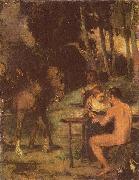 |
Hans von Marees -- Click Here
|
|
(24 December 1837 - 5 June 1887) was a German painter. He mainly painted country scenes in a realistic style.
Von Marees was born in Elberfeld, Germany. At age 16, he was sent to the Berlin Academy. In 1857, he moved to Munich.
In 1869, he visited France, the Netherlands and Spain. He served in the Franco-Prussian War (1870-71) and then lived in Berlin and Dresden for a while. In 1873, he decorated the library walls of the newly built Naples Zoological Institute in Italy. The next year, he moved to Florence.
He died in Rome at the age of 49 and is buried in the Protestant Cemetery there.
|
|
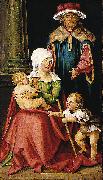 |
Hans von Kulmbach -- Click Here
|
|
(real name Hans Suess or Hans Seß) was born around 1480 in Kulmbach, Franconia and died previous to Dec. 3, 1522 in Nuremberg. Hans von Kulmbach was the artist who created the Krakew St. John's Altar.
Kulmbach probably arrived in Nuremberg around 1505. He received instruction by Jacopo de' Barbari, who for a time worked in Nuremberg. Von Kulmbach then apprenticed with Albrecht Derer and after Derer retired from painting altarpieces in 1510 Kulmbach took over most of his commissions. Kulmbach had his own workshop in Nuremberg and at times worked in Krakew. He also created artworks for emperor Maximilian I and for Margrave Casimir Hohenzollern von Brandenburg-Kulmbach. His best works were stained-glass windows in churches, such as the Maximilian stained-glass, Margrave stained-glass at St. Sebald in Nuremberg, the Welser stained-glass at the Frauenkirche and the Nikolaus altar at Lorenzkirche. In 1511 he finished the St. Mary's altar at Skałka in Krakew. The Catherine and St. John's altar also in Krakew, are among his best works.
|
|
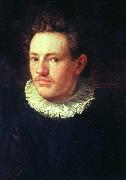 |
Hans von Aachen -- Click Here
|
|
was a German mannerist painter.
His name is derived from the birth place of his father, Aachen in Germany. Other variations of the name include Johann von - and - von Achen and various concisions like Janachen, Fanachen, Abak, Jean Dac, Aquano, van Aken etc.
Hans von Aachen began painting in Germany as a pupil of the Flemish master E. Jerrigh. He then moved to Italy in 1574 to study further. He toured Rome and Florence, but eventually settled in Venice. He initially became a pupil of Kaspar Rems, but soon decided to develop his own mannerist technique, by studying Tintoretto and Michelangelo's followers. However, during all of his life he was influenced by the style of Bartholomeus Spranger and Hendrick Goltzius who dominated the art scene in Germany at the time.
He returned to Germany in 1588 where he became well known as a painter of portraits for noble houses. He painted several works for Duke William V of Bavaria. He married Regina, the daughter of the composer Orlando di Lasso in Munich. In Munich he came into contact with the Imperial Court in Prague. In 1592 he was appointed official painter of Rudolph II, Holy Roman Emperor. However, Von Aachen only moved to Prague in 1601, where he stayed painting commissions from Emperor Rudolph II, and later from Matthias I.
Amongst van Aachens pupils were Peter Isaak and Joseph Heinz. His works have been copied by Wolfgang Kilian, Dominicus Custos and Jan Sadeler.
|
|
 |
Hans Thoma -- Click Here
|
|
German Symbolist Painter, 1839-1924
German painter, printmaker and museum director. He was the son of a miller, craftsman and smallholder and studied briefly as a lithographer in Basle in 1854 before being apprenticed to a watchcase painter in Furtwangen. Returning home the same year, he started to draw and paint in his spare time. In 1859 he enrolled at the Kunstschule in Karlsruhe, where he studied until 1866 with Ludwig Des Coudres (1820-78) and the landscape painter Johann Wilhelm Schirmer, by whom he was especially influenced. He spent his summer vacations drawing and painting in Bernau, and his landscapes, portraits and genre pictures from this time record his transition from amateur painter to accomplished artist. His pictures of his mother and his sister Agathe |
|
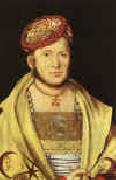 |
Hans Suss von Kulmbach -- Click Here
|
|
1476-1522
German
Hans Suss von Kulmbach Gallery
German painter and graphic artist. His real name was Hans S??ss. In general his work reveals the influence of D??rer, but he had little of the master's power. Von Kulmbach worked chiefly in Nuremberg, although he probably spent several years in Cracow as court painter. His masterpiece is the Tucher altarpiece for the Church of St. Sebald in Nuremberg. He also executed portraits and designs for painted glass.
|
|
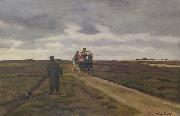 |
Hans Smidth -- Click Here
|
|
Hans Ludvig Smidth (2 October 1839, Nakskov - 5 May 1917, Frederiksberg) was a Danish painter. He is remembered above all for his paintings of Jutland and its local inhabitants.
Smidth was the son of the city bailiff of Skive, Edvard Philip Smidth, and the brother of Verner Frederik Læssøe Smidth who founded the cement concern F. L. Smidth & Co. After graduating from school, he began to study medicine but gave it up in favour of art. In 1861, he entered the Danish Academy where he studied under Niels Simonsen. In 1866, he began to experience financial difficulties and left the Academy to continue his studies himself, painting scenes of Limfjord and the moors of Jutland. He first exhibited at Charlottenborg in 1867 with two landscape paintings and continued to exhibit there over the years. His works depicted country life in Jutland, most of them with an emphasis on animals and local figures. He had a talent for form and detail but his use of colour was rather dry, dimishing the appeal of his paintings to the general public. In 1870-71, he studied under Vilhelm Kyhn. As the years went by, Smidth's style developed considerably, earning him the Neuhausen Prize in 1877 for En fremmed spørger om Vej i Bondegaarden paa Heden which was not only technically impressive but showed a fineness of tone. His increasing acceptance as a master of painting in Jutland paved the way for his reputation at the national level.
In fact Smidth had to wait until the year 1900 before he experienced full recognition. That year the Danish Art Society arranged a special exhibition of the artist's work although he was now 60. Unexpectedly 290 of the 300 works sketches and drawings exhibited were sold. In retrospect, his paintings are free of historical or mythical figures, they do not interpret scenes along the lines of the Skagen Painters. They simply depict the views of the people and the countryside as he saw them. His paintings show he had the same respect for the land as the peasants themselves. |
|
|
|
|
|
 |
Hans Rottenhammer -- Click Here
|
|
German Painter, ca.1564-1626 |
|
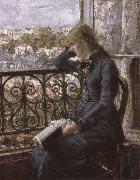 |
Hans Olaf Heyerdahl -- Click Here
|
|
Swedish, 1857-1913
Norwegian painter. He was born into an enlightened but conservative family, his father being an engineer, occasional architect and writer of Nordic saga poetry, and he spent his childhood and youth in the rapidly expanding town of Drammen, 40 km from the capital Christiania. In 1873 he was admitted to the Kongelige Tegneskole in Christiania, where he studied under Peder C. Thurmann, a landscape artist trained in Desseldorf. For more advanced training, Heyerdahl was obliged to go abroad, and in 1874 he enrolled at the Munich Akademie. He was encouraged by Professor Ludwig von Lefftz (1845-1910) to give up landscape in favour of history painting and portraits (e.g. the artists Christian Skredsvig, 1876, and Eilif Peterssen, 1877; both Oslo, N.G.). In 1877, under the guidance of Professor Wilhelm Lindenschmit (1829-95), Heyerdahl finished his most inventive and brilliant composition, the Expulsion from the Garden (Oslo, N.G.). Using over life-size figures, set in a barren tempestuous landscape, Heyerdahl skilfully contrasted the youthful rage of Adam with the resigned despair of Eve. This sombre work won him a third prize medal at the Exposition Universelle in Paris in 1878. |
|
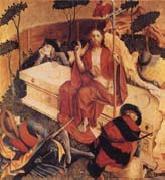 |
Hans Multscher -- Click Here
|
|
German Northern Renaissance Sculptor, ca.1400-1467
German sculptor. Multscher mentions his birthplace on the inscribed band, originally a predella, of the Karg altarpiece in Ulm Cathedral (1433) and on two wings of the so-called 'Wurzach Altar' (1437) at Reichenhofen in the Allgeu. The town archives of Leutkirch, written between 1405 and 1437, record that Multscher belonged to the 'Freien Leute auf Leutkircher Heide', a commune of free peasants who had been able to preserve their independence because they were the direct descendants of Kenigsfreie, who had always been free. Under a charter of Emperor Ludwig in 1337 |
|
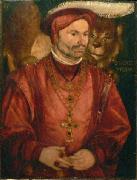 |
Hans Muelich -- Click Here
|
|
painted Court Jester Mertl, Munich in 1545 |
|
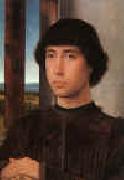 |
Hans Memling -- Click Here
|
|
Netherlandish Northern Renaissance Painter, ca.1435-1494
Born in Seligenstadt, near Frankfurt in the Middle Rhein region, it is believed that Memling served his apprenticeship at Mainz or Cologne, and later worked in the Netherlands under Rogier van der Weyden (c. 1455?C1460). He then went to Bruges around 1465.
There is an apocryphical story that he was a wounded at the Battle of Nancy, sheltered and cured by the Hospitallers at Bruges, and that to show his gratitude he refused payment for a picture he had painted for them. Memling did indeed paint for the Hospitallers, but he painted several pictures for them, in 1479 and 1480, and it is likely that he was known to his patrons of St John, prior to the Battle of Nancy.
Memling is connected with military operations only in a distant sense. His name appears on a list of subscribers to the loan which was raised by Maximilian I of Austria, to defend against hostilities towards France in 1480. In 1477, when he was incorrectly claimed to have been killed, he was under contract to create an altarpiece for the gild-chapel of the booksellers of Bruges. This altarpiece, under the name of the Seven Griefs of Mary, is now in the Gallery of Turin. It is one of the fine creations of his more mature period. It is not inferior in any way to those of 1479 in the hospital of St. John, which for their part are hardly less interesting as illustrative of the master's power than The Last Judgment which can be found since the 1470s in the St. Mary's Church, Gda??sk. Critical opinion has been unanimous in assigning this altarpiece to Memling. This affirms that Memling was a resident and a skilled artist at Bruges in 1473; for the Last Judgment was undoubtedly painted and sold to a merchant at Bruges, who shipped it there on board of a vessel bound to the Mediterranean, which was captured by Danzig privateer Paul Beneke in that very year. This purchase of his pictures by an agent of the Medici demonstrates that he had a considerable reputation. |
|
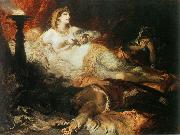 |
Hans Makart -- Click Here
|
|
(May 28, 1840 - October 3, 1884) was a 19th century Austrian academic history painter, designer, and decorator; most well known for his influence on Gustav Klimt and other Austrian artists, but in his own era considered an important artist himself and was a celebrity figure in the high culture of Vienna, attended with almost cult-like adulation.
Makart was the son of a chamberlain at the Mirabell Palace, born in the former residence of the prince-archbishops of Salzburg. Initially, he received his training in painting at the Vienna Academy between 1850 and 1851 from Johann Fischbach. While in the Academy, German art was under the rule of a classicism, which was entirely intellectual and academice clear and precise drawing, sculpturesque modelling, and pictorial erudition were esteemed above all. Makart, who was a poor draughtsman, but who had a passionate and sensual love of color, was impatient to escape the routine of art school drawing. For his fortune, he was found by his instructors to be devoid of all talent and forced to leave the Vienna Academy.
He went to Munich, and after two years of independent study attracted the attention of Karl Theodor von Piloty, under whose guidance, between 1861 and 1865 he developed his painting style. During these years, Makart also travelled to London, Paris and Rome to further his studies. The first picture he painted under Piloty, Lavoisier in Prison, though it was considered timid and conventional, attracted attention by its sense of color.
In his next work, The Knight and the Water Nymphs, he first displayed the decorative qualities to which he afterwards sacrificed everything else in his work. His fame became established in the next year, with two works, Modern Amoretti and The Plague in Florence. His painting Romeo and Juliet was soon after bought by the Austrian emperor for the Vienna Museum, and Makart was invited to come to Vienna by the aristocracy.
The prince Von Hohenlohe provided Makart with an old foundry at the Gusshausstraße 25 to use as a studio. He gradually turned it into an impressive place full of sculptures, flowers, musical instruments, requisites and jewellery that he used to create classical settings for his portraits, mainly of women. Eventually his studio looked like a salon and became a social meeting point in Vienna. Cosima Wagner described it as a "wonder of decorative beauty, a sublime lumber-room". His luxurious studio served as a model for a great many upper middle-class living rooms.
The opulent, semi-public spaces of the Makart atelier were the scene of a recurring rendezvous between the artist and his public. The artist became the mediator between different levels of society: he created a socially ambiguous sphere in which nobility and bourgeoisie could encounter one another in mutual veneration of the master, and aestheticized the burgeoning self-awareness of the bourgeoisie by means of historical models drawn from the world of the aristocracy. In this way, an artist like Makart lived out the image that high society had created of him. Makart is considered by many as being the first art star, referred to by contemporaries an "artist prince" (Malerferst) in the tradition of Rubens.
Makart became the acknowledged leader of the artistic life of the Vienna, which in the 1870s passed through a period of feverish activity, the chief results of which are the sumptuously decorated public buildings of the Ringstraße. He not only practised painting, but was also an interior designer, costume designer, furniture designer, and decorator, and his work decorated most of the public spaces of the era. His work engendered the term "Makartstil", or "Makart style", which completely characterized the era.
In 1879, Makart had designed a pageant organised to celebrate the Silver Wedding Anniversary of the Imperial couple, emperor Franz Josef and his wife Elisabeth of Bavaria he designed, single-handed, the costumes, scenic setting, and triumphal cars. This became known as the "Makart-parade", and had given the people of Vienna the chance to dress up in historical costumes and be transported back into the past for a few hours. At the head of the parade was a float for artists, led by Makart on a white horse. His festivals became an institution in Vienna which lasted up until the 1960s. In the same year as the first parade he became a Professor at the Vienna Academy.
Makart's painting The Entry of Charles V into Antwerp caused some controversy, because Charles V was depicted arriving in a procession surrounded by nude virgins; the offense was the mistaken idea that the nudes had no place in the modern scene. In the United States, the painting fell under the proscription of Anthony Comstock, which secured Makart's fame there. The American public desired at once to see what Comstock was persecuting, so they could tell whether he was acting correctly or in error.
Salzburg's Makart Square, or Makartplatz, was named after the painter.
|
|
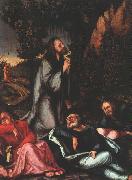 |
Hans Leonhard Schaeufelein -- Click Here
|
|
1480-1540
German
Hans Leonhard Schaeufelein Gallery
Hans Leonhard Schäufelein (c. 1480 ?C 1540) was a German painter, designer, and wood engraver.
He was born in Nuremberg, probably studied under Wohlgemut, and then became the assistant of Durer, whom he imitated. In 1512 he went to Augsburg and in 1515 removed to Nordlingen.
He is a graceful narrator, and his types, though rarely accurately drawn, are attractive, but he lacks power and depth. Characteristic early paintings are the altarpiece at Ober Sankt Veit, near Vienna (1502), "Scenes from the Life of Christ" (Dresden Gallery), and "St. Jerome" (Germanic Museum, Nuremberg).
To his Nordlingen period belong his masterpiece, the so-called "Ziegler Altar" for St. George's Church (1521), part of which is still in the church, part in the museum; "Scenes from the Story of Judith," in the town hall; and the illuminated Psalter for Count von Ottingen, now in the Berlin print room. His most important woodcuts are those for the Theuerdank of Emperor Maximilian.
Schäufelein created a playing card deck about 1535, which is regarded as a highlight in German 16th century playing card production. |
|
 |
Hans Knieper -- Click Here
|
|
painted Portrait of Frederick II of Denmark and Norway in 1581
|
|
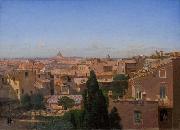 |
Hans Jorgen Hammer -- Click Here
|
|
(29 December 1815, Copenhagen - 28 Januar 1882, Rome) was a Danish artist who specialized in genre painting.
Following an apprenticeship with J.G. Berg in Copenhagen, Hammer was admitted to the Danish Academy in 1828. In 1841, he became a student of Christoffer Wilhelm Eckersberg who remained a close friend. He was awarded the Academy's little silver medal in 1842 and the large silver medal the following year. Det sidste Læs, his entry for the Neuhausen Prize in 1845, was bought by Statens Museum for Kunst but it was not until 1837 that he was awarded the prize with Bønder forsamlede til Lystighed en Søndag Eftermiddag under aaben Himmel.
Hammer was an industrious but rather serious and thoughtful artist. His avid approach to detail slowed down his work considerably. After the outbreak of war in 1848, he became a naval officer. With a stipendium from the Academy, he travelled to Italy in 1857 where he painted Torvet i Ariccia efter Solnedgang, considerably enhancing his reputation in Denmark. The painting was acquired by Statens Museum for Kunst in 1863. Other notable works are Axsamlersken (1866) and Postbudet med det længe ventede Brev (1877). After recovering from a serious illness, he travelled to Rome in 1881 but died there the following year
|
|
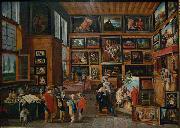 |
Hans Jordaens -- Click Here
|
|
(1555 - 1630), was a Flemish Baroque painter whose religious works are often confused with that of other painters with the same name.
|
|
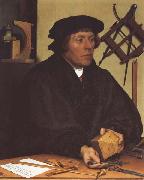 |
Hans holbein the younger -- Click Here
|
|
b. 1497, Augsburg, d. 1543, London
was a German artist and printmaker who worked in a Northern Renaissance style. He is best known as one of the greatest portraitists of the 16th century.[2] He also produced religious art, satire and Reformation propaganda, and made a significant contribution to the history of book design. He is called "the Younger" to distinguish him from his father, Hans Holbein the Elder, an accomplished painter of the Late Gothic school. Born in Augsburg, Holbein worked mainly in Basel as a young artist. At first he painted murals and religious works and designed for stained glass windows and printed books. He also painted the occasional portrait, making his international mark with portraits of the humanist Desiderius Erasmus of Rotterdam. When the Reformation reached Basel, Holbein worked for reformist clients while continuing to serve traditional religious patrons. His Late Gothic style was enriched by artistic trends in Italy, France, and the Netherlands, as well as by Renaissance Humanism. The result was a combined aesthetic uniquely his own. Holbein travelled to England in 1526 in search of work, with a recommendation from Erasmus. He was welcomed into the humanist circle of Thomas More, where he quickly built a high reputation. After returning to Basel for four years, he resumed his career in England in 1532. This time he worked for the twin founts of patronage, Anne Boleyn and Thomas Cromwell. By 1535, he was King's Painter to King Henry VIII. In this role, he produced not only portraits and festive decorations but designs for jewellery, plate, and other precious objects. His portraits of the royal family and nobles are a vivid record of a brilliant court in the momentous years when Henry was asserting his supremacy over the English church. Holbein's art was prized from early in his career. The French poet and reformer Nicholas Bourbon dubbed him "the Apelles of our time".[3] Holbein has also been described as a great "one-off" of art history, since he founded no school.[4] After his death, some of his work was lost, but much was collected, and by the 19th century, Holbein was recognised among the great portrait masters. Recent exhibitions have also highlighted his versatility. |
|
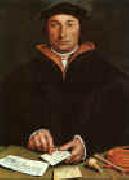 |
Hans Holbein -- Click Here
|
|
German
1497-1543
Hans Holbein Galleries
Holbein always made highly detailed pencil drawings of his portrait subjects, often supplemented with ink and colored chalk. The drawings emphasize facial detail and usually did not include the hands; clothing was only indicated schematically. The outlines of these drawings were then transferred onto the support for the final painting using tiny holes in the paper through which powdered charcoal was transmitted; in later years Holbein used a kind of carbon paper. The final paintings thus had the same scale as the original drawings. Although the drawings were made as studies for paintings, they stand on their own as independent, finely wrought works of art. How many portraits have been lost can be seen from Holbein's book (nearly all pages in the Royal Collection) containing preparatory drawings for portraits - of eighty-five drawings, only a handful have surviving Holbein paintings, though often copies have survived.
David Hockney has speculated in the Hockney-Falco thesis that Holbein used a concave mirror to project an image of the subject onto the drawing surface. The image was then traced. However this thesis has not met with general acceptance from art historians.
A subtle ability to render character may be noted in Holbein's work, as can be seen in his portraits of Thomas Cromwell, Desiderius Erasmus, and Henry VIII. The end results are convincing as definitive images of the subjects' appearance and personality. |
|
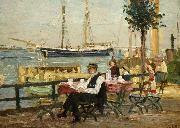 |
Hans Hartig -- Click Here
|
|
painted Im Hafen von Neuwarp in 1918 |
|
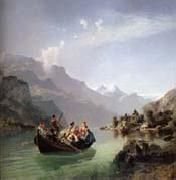 |
Hans Gude -- Click Here
|
|
March 13, 1825 ?C August 17, 1903,Norwegian painter. He was the most renowned Norwegian landscape painter of his time. At the age of 12 he was enrolled as a pupil of Johannes Flintoe (1787-1880). After attending evening classes at the Kongelige Tegneskole in Christiania, he went to D?sseldorf in 1841 to study privately with the landscape painter Andreas Achenbach (1815-1910). In 1842 Gude was admitted to the landscape class at the Akademie under Johann Wilhelm Schirmer. He was later appointed an assistant teacher at Schirmer private studio, and he succeeded his master as Professor of landscape painting both at the D?sseldorf Akademie (1854-62) and at the Karlsruhe Akademie (1864-80). In the 1840s Gude established his reputation in Norway and on the Continent with powerful images of the Norwegian mountains. These were shown in the Kunstforening galleries in D?sseldorf and Christiania and at the Berliner Akademische Kunstausstellung, where Gude exhibited throughout his life. Adolph Tidemand and Gude dominated the colony of Norwegian artists who studied in D?sseldorf in the mid-19th century. The two artists worked together on five paintings, all representing people in boats; Gude painted the landscape, Tidemand the figures. The Bridal Procession at Hardanger (1848; Oslo, N.G.) celebrates a ceremony of country life and is the most famous work of Norwegian National Romanticism. In a sunny western Norwegian landscape with snow on the high mountains, the bridal couple and wedding guests in national costume are shown rowing across the water from a medieval stave church on the headland in the background. Gude revealed greater maturity in High Mountain (1857; Oslo, N.G.). The disposition of mountains massed on the high plateau around a little lake produces an effect of monumentality. The predominant colours shade from grey to blue, concentrated in the cloud cover. The influence of Schirmer tranquil landscapes is apparent, while the rhythmic arrangement of light and shadow is reminiscent of Achenbach. |
|
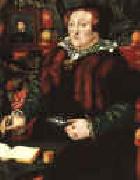 |
Hans Eworth -- Click Here
|
|
Flemish Northern Renaissance Painter, active 1540-1573
Flemish painter, active in England. Jan Euworts was listed in 1540 as a freeman of the Guild of St Luke in Antwerp, but by 1545 he had moved to England, where until 1571 his name, spelt in a wide variety of ways (e.g. Eeworts, Eottes, Euertz, Evance, Eworts, Ewotes, Ewout, Ewoutsz., Eywooddes, Hawarde, Heward, Huett etc), appeared in numerous naturalization, tax and parish documents. About 35 paintings are generally attributed to him, consisting primarily of dated portraits of the English gentry and nobility. The majority are signed with the monogram HE, which led to their being attributed to the Flemish painter Lucas de Heere during the 18th and 19th centuries. Cust reattributed the paintings to Eworth on the basis of an inventory (1590) of the collection of John, 1st Baron Lumley, in which three monogrammed portraits were listed as being by Haunce Eworth |
|
 |
Hans Cranach -- Click Here
|
|
(ca. 1513-1537), also known as Johann Lucas Cranach, was a German painter, the oldest son of Lucas Cranach the Elder. German art historian Christian Schuchardt, who discovered his existence, credits him with an altar-piece at Weimar, signed with the monogram "H. C.", and dated 1537. He died at Bologna in 1537. Luther mentions his death in his "Table Talk", and Johann Stigel, a contemporary poet, celebrates him as a painter.
|
|
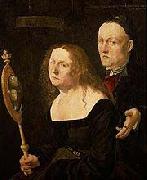 |
Hans Burgkmair -- Click Here
|
|
(1473 - 1531) was a German painter and printmaker in woodcut.
Burgkmair was born in Augsburg, the son of painter Thomas Burgkmair
and his son, Hans the Younger, became one too. From 1488 he was a pupil of Martin Schongauer in Colmar, who died during his two years there, before Burgkmair completed the normal period of training. He may have visited Italy at this time, and certainly did so in 1507, which greatly influenced his style. From 1491 he was working in Augsburg, where he became a master and opened his own workshop in 1498.
Hollstein ascribes 834 woodcuts to him, mostly for book illustrations, with slightly over a hundred being "single-leaf", that is prints not for books. The best of them show a talent for striking compositions, and a blend, not always fully successful, of Italian Renaissance forms and underlying German style. From about 1508 he spent much of his time working on the woodcut projects of Maximilian I until the Emperor's death in 1519. He was responsible for nearly half of the 135 prints in the Trumphs of Maximilian, which are large and full of character. He also did most of the illustrations for Weiss Kunig and much of Theurdank.
He was an important innovator of the chiaroscuro woodcut, and seems to have been the first to use a tone block, in a print of 1508.His Lovers Surprised by Death (1510) is the first chiaroscuro print to use three blocks.and also the first print that was designed to be printed only in colour, as the line block by itself would not make a satisfactory image. Other chiaroscuro prints from around this date by Baldung and Cranach had line blocks that could be and were printed by themselves.He produced one etching, Venus and Mercury (c1520),etched on a steel plate, but never tried engraving, despite his training with Schongauer. |
|
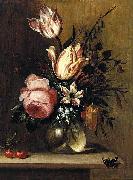 |
Hans Bollongier -- Click Here
|
|
(1600-idem, 1645) was a Dutch Golden Age still life flower painter.
Bollongier was born in Haarlem. According to the RKD little is known of his early life. He became a member of the Haarlem Guild of St. Luke in 1623, and in 1675 his younger brother Horatio was named as his beneficiary. He was a specialist in bouquets of blooms. Paintings attributed to him that are not flower- or fruit still lifes are likely the work of his brother Horatio.He was an important influence on the later flower painters known as the monogrammist JF and Anthony Claesz II. He painted during a period of great productivity for Haarlem painters, during the decades after Karel van Mander published his Schilderboeck there. In Karel van Mander's book, there were a set of rules to follow to create good paintings and good drawings. Bollongier developed his own style and still observed all of these rules. His paintings were very popular, but his work was not regarded as such by contemporary Haarlem painters. As a genre, still life painting was considered inferior to historical allegories.
His work today is considered part of the proof that Tulip Mania took place, although there is reason to believe that this is also just part of early Haarlem tourist propaganda. Even as early as the 17th century, gentry from Amsterdam, Leiden, and places farther away enjoyed visiting the tulip fields of Haarlem in the Spring, and paintings of tulips were as popular as the bulbs.
|
|
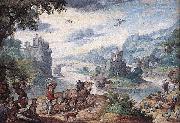 |
Hans Bol -- Click Here
|
|
(1534 - 1593), Flemish artist, received his early training from his two uncles who were also painters. He then was the apprentice to a Mechelen watercolorist and tempera painter at the age of fourteen. Because Boles watercolors became so widely reproduced, he began creating miniatures on parchment. The technique earned him many international clients and a good income. In addition, Bol also produced several oil paintings, illuminated manuscripts, drawings, and engravings. He preferred to create landscapes, mythological, allegorical and biblical scenes, and genre paintings.
Bol was a mannerist, which followed the High Renaissance.
One of his most famous works of art is Landscape with the Fall of Icarus, made with watercolours on paper. It was inspired by Ovid's Metamorphoses, in which the ancient myth of Icarus is told. The painting is a marvelous example of the art of landscape. Subtle colour transitions, skilful perspective and effective contrasts between foreground and background, and human figures and the forces of nature, lend this miniature painting a cosmic dimension.
Bol chose the Icarus theme on several occasions. It was also subject of one of his paintings, which described in detail and highly praised by Karel van Mander in the 17th century. Although Bol was once an important and admired painter, we only know him through his small drawings and watercolours. Most of his paintings appear to have been lost. This miniature is all the more important, because it probably produces the painting referret to by Van Mander, which may have been his masterpiece. Consequently, Bol ought to be viewed not only as a superior miniature painter, but above all as an important artist who played a key role in the development of landscape art.
|
|
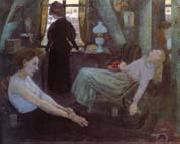 |
Hans Baluschek -- Click Here
|
|
German, 1870-1935,German illustrator, painter, and writer, known for his graphic depictions of the proletarian milieu and hard life in big cities. Baluschek was also a renowned illustrator of fairy tales and produced superb illustrations for five books in the series Deutsche Marchenbucherei published by the Klemm Verlag between 1878 and 1923: Peterchens Mondfahrt (Little Peter's Flight to the Moon, 1915), Pips der Pilz. Ein Wald?\ und Weihnachtsmarchen (Pips the Mushroom: A Forest and Christmas Fairy Tale, 1920), Prinzessin Huschewind (Princess Hush Wind, 1922), and Ins Marchenland (Into Fairyland, 1922). He employed aquarelles and oils to form unusual and bizarre characters and also used ink to create the text. |
|
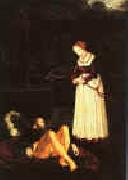 |
Hans Baldung Grien -- Click Here
|
|
German
1485-1545
Hans Baldung Grien Galleries
The earliest pictures assigned to him by some are altar-pieces with the monogram H. B. interlaced, and the date of 1496, in the monastery chapel of Lichtenthal near Baden-Baden. Another early work is a portrait of the emperor Maximilian, drawn in 1501 on a leaf of a sketch-book now in the print-room at Karlsruhe. "The Martyrdom of St Sebastian and the Epiphany" (Berlin Museum), fruits of his labour in 1507, were painted for the market-church of Halle in Saxony.
Baldung's prints, though D??reresque, are very individual in style, and often in subject. They show little direct Italian influence. His paintings are less important than his prints. He worked mainly in woodcut, although he made six engravings, one very fine. He joined in the fashion for chiaroscuro woodcuts, adding a tone block to a woodcut of 1510.[1] Most of his hundreds of woodcuts were commissioned for books, as was usual at the time; his "single-leaf" woodcuts (ie prints not for book illustration) are fewer than 100, though no two catalogues agree as to the exact number.
He was extremely interested in witches and made many images of them in different media, including several very beautiful drawings finished with bodycolour, which are more erotic than his treatments in other techniques.
Witch and Dragon. Drawing with bodycolour (b/w repro)Without absolute correctness as a draughtsman, his conception of human form is often very unpleasant, whilst a questionable taste is shown in ornament equally profuse and baroque. Nothing is more remarkable in his pictures than the pug-like shape of the faces, unless we except the coarseness of the extremities. No trace is apparent of any feeling for atmosphere or light and shade. Though Gr??n has been commonly called the Correggio of the north, his compositions are a curious medley of glaring and heterogeneous colours, in which pure black is contrasted with pale yellow, dirty grey, impure red and glowing green. Flesh is a mere glaze under which the features are indicated by lines. (1911)
His works are mainly interesting because of the wild and fantastic strength which some of them display. His Eve, the Serpent and Death (National Museum of Canada) shows his strengths well. We may pass lightly over the "Epiphany" of 1507, the "Crucifixion" of 1512, or the "Stoning of Stephen" of 1522, in the Berlin Museum. There is some force in the "Dance of Death" of 1517, in the museum of Basel, or the Madonna of 1530, in the Liechtenstein Gallery at Vienna. Gr??n's best effort is the altarpiece of Freiburg, where the Coronation of the Virgin, and the Twelve Apostles, the Annunciation, Visitation, Nativity and Flight into Egypt, and the Crucifixion, with portraits of donors, are executed with some of that fanciful power which Martin Schongauer bequeathed to the Swabian school.
As a portrait painter he is well known. He drew the likeness of Charles V, as well as that of Maximilian; and his bust of Margrave Philip in the Munich Gallery tells us that he was connected with the reigning family of Baden, as early as 1514. At a later period he had sittings from Margrave Christopher of Baden, Ottilia his wife, and all their children, and the picture containing these portraits is still in the grand-ducal gallery at Karlsruhe. Like D??rer and Cranach, Gr??n became a hearty supporter of the Reformation. He was present at the diet of Augsburg in 1518, and one of his woodcuts represents Luther under the protection of the Holy Ghost, which hovers over him in the shape of a dove. |
|
|
|
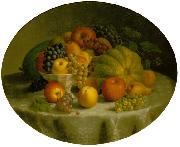 |
Hannah Brown Skeele -- Click Here
|
|
Hannah Brown Skeele (1829 - 1901) |
|
 |
Hanna Mehls -- Click Here
|
|
painted Blumenstillleben in 1900 |
|
|
|
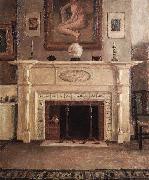 |
Hamilton Easter Field -- Click Here
|
|
(1873-1922) was an important American artist, teacher, author, critic, collector and patron of the arts |
|
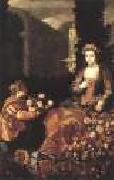 |
HAMEN, Juan van der -- Click Here
|
|
Spanish painter (b. 1596, Madrid, d. 1631, Madrid).
was a Spanish painter, a master of the still life paintings, also called bodegones. During his lifetime, he was prolific and versatile, painting allegories, landscapes, and large-scale works for churches and convents. However, today he is remembered mostly for his still lifes. In the 1620s, He popularized still life painting in Madrid. Juan van der Hamen y Leon was baptized on 8 April 1596 in Madrid, therefore, he must have been born there just days before that date. He was the son of Jehan van der Hamen, a Flemish courtier, who had moved to Madrid from Brussels before 1586, and Dorotea Whitman Gemez de Leon, a half-Flemish mother of noble Toledan ancestry . Van der Hamen and his two brothers Pedro and Lorenzo (both of whom were writers) emphasized their Spanish roots by using all or part of their maternal grandmother's family name, Gemez de Leon. The painter's father, Jan van der Hamen, had come to Spain, as an archer, to the court of Philip II were he settled, married, and his children were born. According to 18th-century sources, the artist's father had also been a painter, but there is no evidence for this. Juan van der Hamen inherited his father's honorary positions at court and also served as unsalaried painter of the king. Van der Hamen's artistic activity in the service of the crown is first recorded on 10 September 1619, when he was paid for painting a still-life for the country palace of El Pardo, to the north of Madrid. Noted for his versatility, Juan van der Hamen painted religious history paintings; allegories, landscapes, low-life subjects, portraits and still-lifes but the last two categories brought him the greatest fame. He served at the courts of Philip III and Philip IV and established the popularity of the new genre of still-life in Madrid in the 1620s. A prolific artist, van der Hamen painted all his works during the first decade of the reign of Philip IV. It is known that he painted more still lifes in 1622 than in any other period of his life. He also reached great personal fame as a portraitist, being this field, the one that provided him with greater personal success, since still life was considered a lesser genre. He executed a portrait of Philip IV and worked during the 1620s in a series of portraits of the principal intellectuals and writers of his time, including: Lope de Vega, Francisco de Quevedo, Luis de Gengora, Jose de Valdivieso, Juan Perez de Montalbon, Juan Ruiz de Alarcen and Francisco de Rioja. On van der Hamen's death, twenty of these portraits were inventoried as a single item among his belongings. The portrait of his older brother, Lorenzo van der Hamen, probably belonged to this series. The series itself was a focal point for philosophic speculation on the art of portraiture by some of the most distinguished minds of the time, who frequently praised Juan van der Hamen in verse and prose. Among Van der Hamen portraits, there is one of a dwarf, painted around 1623 in a powerful naturalistic style. This painting (Madrid, Museo del Prado) anticipated the later made by Velezquez. In 1626, van der Hamen painted cardinal Francesco Barberini, after a previous portrait by Velezquez had failed to please the sitter. Well satisfied with his work Cardinal Barberini acquired three further works from him. As a religious painter Juan van der Hamen worked for several religious institutions in and around Madrid and Toledo, like the Monastery of the Descalzas Reales, in Madrid, for which he painted altars. Few of these paintings are extant. The best surviving examples of his religious work are in the cloister of the Royal Convent of La Encarnacion in Madrid, painted in 1625 in a naturalistic tenebristic style. Juan van der Hamen was also a pioneer in the field of flower painting. Van der Hamen probably began painting floral arrangements in response to the flower pieces of Flemish artists, such as Jan Brueghel, who were regarded as exemplary masters in the field and whose works were much sought after in Spain. One good example of his work as a flower painter is his Offering to Flora , a visual poem that parallels the lyric verse of his time, in which he united his skills as portraitist and flower painter to produce one of the most beautiful paintings of the allegory of spring. |
|
 |
HALS, Frans -- Click Here
|
|
Dutch painter (b. 1580, Antwerpen, d. 1666, Haarlem). |
|
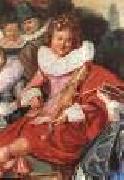 |
HALS, Dirck -- Click Here
|
|
Dutch painter (b. 1591, Haarlem, d. 1656, Haarlem).
Brother of Frans Hals. From 1618 to 1624 and again in 1640 he was an amateur of the Haarlem chamber of rhetoric known as De Wijngaertrancken, to which Frans also belonged. He was enrolled in the Guild of St Luke in Haarlem from 1627 to his death. As Blade has established on stylistic grounds, Dirck collaborated with the architectural painter Dirck van Delen from that year until 1634, with Hals painting the figures. On 4 April 1634 a lottery of paintings was announced, organized by Dirck Hals (who sent some of his own pictures) and Cornelis van Kittensteijn in the inn De Basterdpijp in Haarlem. The following year, on 20 June 1635, the notary van Leeuwen at Leiden authorized Dirck Hals to collect moneys for Pieter Jansz. van den Bosch of Leiden in connection with the proceeds of paintings sold at Haarlem. On 2 March 1643 Dirck Hals signed as a witness in the presence of the notary Willem van Vredenburch at Leiden. |
|
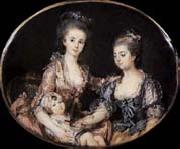 |
HALL, Peter Adolf -- Click Here
|
|
1739-1793
Swedish painter and collector. In 1753 he attended Uppsala Universitet to study medicine and natural history. In 1755 he went on a study trip abroad, led by his drawing-master Lars Brisman. While in Germany (1756-9) he studied miniature painting with Eichhardt in Berlin and with Karl Friedrich Wilhelm Richard (1725-70) in Hamburg. After this trip, he decided to become a professional portrait painter, and in 1759 he enrolled at the Kungliga Akademi for de Fria Konsterna in Stockholm, studying drawing with the French sculptor Pierre-Hubert Larchaveque (1721-78) and painting with Gustaf Lundberg. He attracted the attention of C. F. Adelcrantz, who in 1766 gained for him a commission for the pastel portrait of Princes Karl and Fredrik Adolf. In that year he also executed a miniature portrait of Crown Prince Gustav on the occasion of his engagement to Princess Sophia Magdalena of Denmark. Also in 1766 he received a royal travel grant to study in Paris, where he developed a completely new technique of miniature painting using sweeping brushwork and a clear and fresh range of colour that allowed for lively characterization. He made exquisite detailed studies of the backgrounds of his paintings, as well as his sitters costumes and their attributes and accessories. His new technique involved applying gouache to the ivory in a manner that allowed the ivory to show through, a method that was particularly successful in depicting drapery. The smooth surface of the ivory also allowed freer brushwork associated with full-scale portraits. |
|
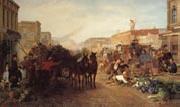 |
Hahn William -- Click Here
|
|
American Painter, 1829-1887 |
|
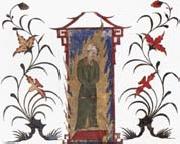 |
Hafiz i Abru -- Click Here
|
|
the period of 1465-1535
|
|
 |
Haberle John -- Click Here
|
|
American Painter, 1856-1933
was a 19th century American painter in the trompe l'oeil (literally, "fool the eye") style. His still lifes of ordinary objects are painted in such a way that the painting can be mistaken for the objects themselves. He is considered one of the three major figures??together with William Harnett and John F. Peto??practicing this form of still life painting in the United States in the last quarter of the 19th century. A Bachelor's Drawer by John Haberle, 1890?C94, oil on canvas, 50.8 x 91.4 cm, Metropolitan Museum of Art, New YorkHaberle was born in New Haven, Connecticut; his parents were Swiss immigrants. At the age of 14 he left school to apprentice with an engraver. He also worked for many years as an exhibit preparator for the Peabody Museum of Natural History at Yale University. His career as a painter began in 1887. His style is characterized by a meticulous rendering of two-dimensional objects. He is especially noted for his depictions of paper objects, including currency. Art historian Alfred Frankenstein has contrasted Haberle's work with that of his contemporaries: Peto is moved by the pathos of used-up things. Haberle is wry and wacky, full of bravado, self-congratulating virtuosity, and sly flamboyance. He works largely within an old tradition, that of the trompe l'oeil still life in painted line ... It is poles away from Harnett's sumptuosity, careful balances, and well-modeled volumes, and is equally far from Peto's sensitivity in matters of tone and hue. |
|
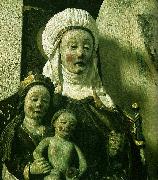 |
haaken gullesons -- Click Here
|
|
Ytterlännäs parish, in the province of Ångermanland, belonged to the Archdiocese of Uppsala in the Middle Ages, but has been part of the Diocese of Härnösand since that was formed in 1647. The two churches of he parish, the old one from the early 13th century, and the new one from 1848-1854, are located between the communities of Nyland and Bollstabruk, within Kramfors Municipality.
The Ytterlännäs New Church taken into use in 1854 is an example of the style known as a tegnarlada ("Tegnor barn") - spacious, white, clean, neo-classical. The Ytterlännäs Old Church (Ytterlännäs Gamla Kyrka) dates from the 1200s and features medieval vaults, wall-paintings and wooden sculptures, and baroque furnishings including the unusual feature of two galleries; the Ytterlännäs Madonna is regarded by experts as a particularly fine example of the work from the Hälsingland workshop of Haaken Gulleson, all in an excellent state of preservation thanks to the church's being abandoned after 1854. |
|
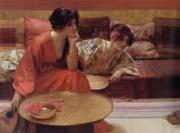 |
H.Siddons Mowbray -- Click Here
|
|
American Painter, 1858-1928 |
|
|
|
|
|
 |
Gustavus Hesselius -- Click Here
|
|
(1682 - May 25, 1755) was a Swedish born painter who emigrated to the New World in 1711. He was the father of painter John Hesselius and cousin of the religious leader Emanuel Swedenborg.
Hesselius left his home country of Sweden for Wilmington, Delaware in 1711. There he lived until 1717 when he moved to Philadelphia, Pennsylvania, where he lived until 1721. In 1721, he moved to Prince George's County, Maryland and became a portrait painter, though he had been trained in Sweden. That same year, he received the first recorded public art commission in the American colonies, he painted The Last Supper. He also painted a Crucifixion. Some time around 1735, Hesselius returned to Philadelphia where spent the rest of his life and traveling. He was listed as a member of the Gloria Dei (Old Swedes') Church in Philadelphia.
He also worked as an organ builder, having built an organ for the Moravian Church in Bethlehem, Pennsylvania in 1746. From about this time on, he focused on building organs, referring painting commissions to his son John.
J. Hall Pleasants has said that Hesselius became "America's earliest portrait painter of note." In 1994 he was named to the Prince George's County Hall of Fame.
|
|
|
|
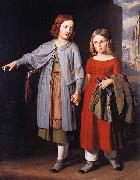 |
Gustav Adolph Hennig -- Click Here
|
|
Gustav Adolph Hennig (1797-1869)Professions: Historical-scenes painter; Porträtmaler; Miniature painter; Etcher; Lithographer. |
|
|
|
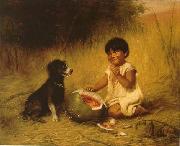 |
Grace Hudson -- Click Here
|
|
(1865 - 1937) was an American painter. She was nationally known during her lifetime for a numbered series of more than 684 portraits of the local Pomo Indians. She painted the first, "National Thorn", after her marriage in 1891, and the last in 1935.
Grace Carpenter was born in Potter Valley, California. Her mother was one of the first white school teachers educating Pomo children and was a commercial portrait photographer in Ukiah, California; her father was a skilled panoramic and landscape photographer who chronicled early Mendocino County frontier enterprises such as logging, shipping and railroading. At fourteen years of age, Grace was sent to attend the recently-established San Francisco School of Design, an art school which emphasized painting from nature rather than from memory or by copying existing works. At sixteen, she executed an award-winning, full length, life sized self-portrait in crayon. While in San Francisco, she met and eloped with a man fifteen years her senior named William Davis, upsetting her parents and ending her formal studies. The marriage lasted only a year.
From 1885 to 1890, Grace Carpenter Davis lived with her parents in Ukiah painting, teaching and rendering illustrations for magazines such as Cosmopolitan and Overland Monthly. Her work at that time had no particular focus and included genre, landscapes, portraits and still lifes in all media. Later in her career she would continue to accept occasional magazine illustration assignments including ones for Sunset.
|
|
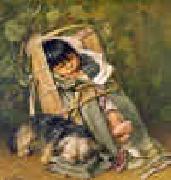 |
Grace Carpenter Hudson -- Click Here
|
|
1865-1937
Grace Carpenter Hudson Galleries
Grace Carpenter Hudson (1865 - 1937) was an American painter. She was nationally known during her lifetime for a numbered series of more than 684 portraits of the local Pomo Indians. She painted the first, "National Thorn", after her marriage in 1891, and the last in 1935.
Grace Carpenter was born in Potter Valley, California. Her mother was one of the first white school teachers educating Pomo children and was a commercial portrait photographer in Ukiah, California; her father was a skilled panoramic and landscape photographer who chronicled early Mendocino County frontier enterprises such as logging, shipping and railroading.[1] At fourteen years of age, Grace was sent to attend the recently-established San Francisco School of Design, an art school which emphasized painting from nature rather than from memory or by copying existing works. At sixteen, she executed an award-winning, full length, life sized self-portrait in crayon. While in San Francisco, she met and eloped with a man fifteen years her senior named William Davis, upsetting her parents and ending her formal studies. The marriage lasted only a year.
From 1885 to 1890, Grace Carpenter Davis lived with her parents in Ukiah painting, teaching and rendering illustrations for magazines such as Cosmopolitan and Overland Monthly. Her work at that time had no particular focus and included genre, landscapes, portraits and still lifes in all media. Later in her career she would continue to accept occasional magazine illustration assignments including ones for Sunset. |
|
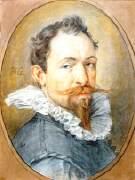 |
GOLTZIUS, Hendrick -- Click Here
|
|
Dutch Baroque Era Painter and Engraver, 1558-1617
Dutch draughtsman, printmaker, print publisher and painter. He was an important artist of the transitional period between the late 16th century and the early 17th, when the conception of art in the northern Netherlands was gradually changing. Goltzius was initially an exponent of Mannerism, with its strong idealization of subject and form. Together with the other two well-known Dutch Mannerists, Karel van Mander I and Cornelis Cornelisz. van Haarlem, he introduced the complex compositional schemes and exaggeratedly contorted figures of Bartholom?us Spranger to the northern Netherlands. These three artists are also supposed to have established an academy in Haarlem in the mid-1580s, but virtually nothing is known about this project. In 1590 Goltzius travelled to Italy, thereafter abandoning Spranger as a model and developing a late Renaissance style based on a broadly academic and classicizing approach. Later still, his art reflected the growing interest in naturalism that emerged in the northern Netherlands from c. 1600. |
|
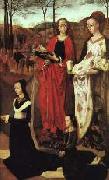 |
GOES, Hugo van der -- Click Here
|
|
Netherlandish Northern Renaissance Painter, ca.1440-1482
South Netherlandish painter. In 1467 he enrolled as master in the Ghent painters' guild, sponsored by Joos van Wassenhove, master painter in Ghent in 1464 after registering in Antwerp in 1460. In 1469 the two together acted as guarantors for the illuminator Sanders Bening when he became a master, and it was from Hugo that Joos borrowed money when he went to Rome. Sanders Bening was married to Kathelijn van der Goes, perhaps Hugo's sister. Hugo's status within the guild is further attested by the fact that he was guarantor for two other painters in 1471 and 1475, that he was one of the dean's jurors in 1468-9 and that he himself served as dean from towards the end of 1473-4 to at least 18 August 1475. |
|
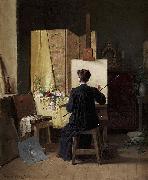 |
Gillis Hafstrom -- Click Here
|
|
Sweden (1841 -1909 ) - Painter
Gillis Hafström |
|
|
|
 |
Gerrit van Honthorst -- Click Here
|
|
1590-1656
Dutch
Gerrit Van Honthorst Galleries
Gerard van Honthorst (November 4, 1592 - April 27, 1656), also known as Gerrit van Honthorst and Gherardo della Notte, was a Dutch painter of Utrecht. He was brought up at the school of Abraham Bloemaert, who exchanged the style of the Franckens for that of the pseudo-Italians at the beginning of the 16th century.
Margareta Maria de Roodere and Her Parents by Gerrit van Honthorst (1652) Oil on canvas, 140 x 170 cm. Centraal Museum, UtrechtInfected thus early with a mania which came to be very general in the Netherlands, Honthorst went to Italy in 1616, where he copied the naturalism and eccentricities of Michelangelo da Caravaggio. Home again about 1620, after acquiring a considerable practice in Rome, he set up a school at Utrecht which flourished exceedingly. Together with his colleague Hendrick ter Brugghen, he represented the so-called Dutch Caravaggisti. In 1623 he was president of his gild at Utrecht, where he had married his cousin. He soon became so fashionable that Sir Dudley Carleton, then English envoy at The Hague, recommended his works to the earl of Arundel and Lord Dorchester. In 1626 he received a visit from Rubens, whom he painted as the honest man sought for and found by Diogenes.
The queen of Bohemia, sister of Charles I of England and electress palatine, being in exile in the Netherlands, gave Honthorst her countenance and asked him to teach her children drawing; and Honthorst, thus approved and courted, became known to her brother Charles I, who invited him to England in 1628. There he painted several portraits, and a vast allegory, now at Hampton Court, of Charles and his queen as Diana and Apollo in the clouds receiving the duke of Buckingham as Mercury and guardian of the king of Bohemia's children. Charles I, whose taste was flattered alike by the energy of Rubens and the elegance of Van Dyck, was thus first captivated by the fanciful mediocrity of Honthorst, who though a poor executant had luckily for himself caught, as Lord Arundel said, much of the manner of Caravaggio's colouring, then so much esteemed at Rome. |
|
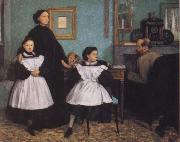 |
German Hilaire Edgar -- Click Here
|
|
1834-1917
Impressionism,Frechen
|
|
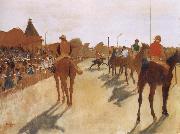 |
Germain Hilaire Edgard Degas -- Click Here
|
|
1834-1917
impressionism,French |
|
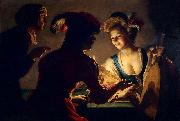 |
Gerard van Honthorst -- Click Here
|
|
(November 4, 1592 - April 27, 1656), also known as Gerrit van Honthorst and Gherardo della Notte, was a Dutch painter of Utrecht. He was brought up at the school of Abraham Bloemaert, who exchanged the style of the Franckens for that of the pseudo-Italians at the beginning of the 16th century.
Margareta Maria de Roodere and Her Parents by Gerrit van Honthorst (1652) Oil on canvas, 140 x 170 cm. Centraal Museum, UtrechtInfected thus early with a mania which came to be very general in the Netherlands, Honthorst went to Italy in 1616, where he copied the naturalism and eccentricities of Michelangelo da Caravaggio. Home again about 1620, after acquiring a considerable practice in Rome, he set up a school at Utrecht which flourished exceedingly. Together with his colleague Hendrick ter Brugghen, he represented the so-called Dutch Caravaggisti. In 1623 he was president of his gild at Utrecht, where he had married his cousin. He soon became so fashionable that Sir Dudley Carleton, then English envoy at The Hague, recommended his works to the earl of Arundel and Lord Dorchester. In 1626 he received a visit from Rubens, whom he painted as the honest man sought for and found by Diogenes. |
|
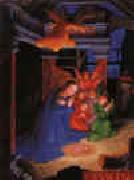 |
Gerard Hornebout -- Click Here
|
|
Flemish Northern Renaissance Painter and Manuscript Illuminator, ca.1465-1541 |
|
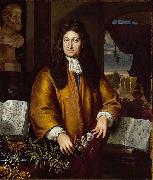 |
Gerard Hoet -- Click Here
|
|
(1648 - 1733), was a Dutch Golden Age painter.
Gerard Hoet trained with his father and brother who were glass painters, and Warnard van Rijsen, who lived in Zaltbommel, and who himself was a pupil of Cornelis van Poelenburgh in Utrecht. In 1672 Hoet moved to The Hague, but when the Count of Salis bought paintings at his mother's house in Zaltbommel, he returned to paint for him. He accompanied him to Rees, Germany, where he met the Utrecht painters Jan van Bunnik, Justus Nieuwpoort and Andries de Wit.With De Wit he returned to Utrecht, where he worked for Frederick Nassau de Zuylestein briefly before visiting the Hague and Amsterdam. He then travelled to France on the promise of a Marquis who wanted to give him a commission, but this promise falling through, he made some engravings of paintings by Francisque Millet.He then wanted to travel to England, but having written to his compatriot Lucas Vorsterman, he received word that there was more work to be had in Paris. Hoet travelled to Paris where he spent more than a year, before returning to the Netherlands via Brussels.In Brussels he met the painter Adriaen Frans Boudewyns, who convinced him to stay a while. After eight months, Hoet returned to Utrecht, where he worked for William Nassau de Zuylestein, 1st Earl of Rochford. He married and settled in Heemstede (Utrecht), where he found work for the lord of the castle there |
|
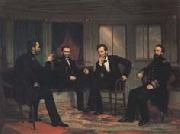 |
George P.A.Healy -- Click Here
|
|
American Painter, 1813-1894
American painter, active also in Europe. At the age of 17 he set up a studio in Boston after receiving encouragement from Thomas Sully, who was painting portraits there. Despite his youth and lack of training, he presented himself to the society figure Mrs Harrison Gray Otis and asked if he might paint her portrait (untraced); she agreed and later sponsored Healy's first trip abroad. In 1834 he entered the studio of Antoine-Jean Gros; the French master's suicide the following year ended Healy's only sustained period of artistic study. In Gros's studio he first encountered Thomas Couture, but they did not meet again until the next decade |
|
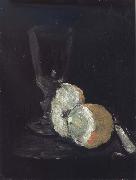 |
George Leslie Hunter -- Click Here
|
|
Scottish Painter, 1877-1931 |
|
|
|
 |
George Hitchcock -- Click Here
|
|
1850-1913
George Hitchcock (1850 - 1913), American artist, was born in Providence, Rhode Island.
Hitchcock graduated from the University of Manitoba, and from Harvard Law School in 1874. He then turned his attention to art and became a pupil of Gustave Boulanger and Jules-Joseph Lefebvre in Paris.
He attracted notice in the Paris Salon of 1885 with his "Tulip Growing", of a Dutch garden he painted in the Netherlands. For years he had a studio at Egmond-aan-Zee, in the Netherlands. He became a ch??valier of the French Legion of Honour; a member of the Vienna Academy of Arts, the Munich Secession Society, and other art bodies; and is represented in the Dresden gallery; the imperial collection in Vienna; the Chicago Art Institute, and the Detroit Institute of Arts. |
|
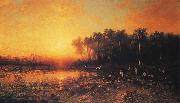 |
George Herbert McCord -- Click Here
|
|
(1848 -1909 ) - Painter
|
|
 |
George Henry Harlow -- Click Here
|
|
British
1787-1819
He was born in St. James's Street, London, on 10 June 1787, the posthumous son of a China merchant, who after some years' residence in the East had died about five months before his son's birth, leaving a widow with five infant daughters. Indulged and petted by his mother, Harlow was sent when quite young to Dr. Barrow's classical school in Soho Square, and subsequently to Mr. Roy's school in Burlington Street. He was for a short time at Westminster School, but having shown a predilection for painting, he was placed under Henry De Cort, the landscape-painter. He next worked under Samuel Drummond, A.R.A., the portrait-painter, but after about a year entered the studio of Sir Thomas Lawrence, P.R.A. This step is said to have been taken at the suggestion of Georgiana, duchess of Devonshire; but Harlow's natural affinity to Lawrence's style in painting would be quite sufficient to account for his choice. Harlow paid Lawrence handsomely for his admission and the right to copy, but according to the contract was not entitled to instruction.
Harlow now determined to devote himself to painting, and refused an offer of a writership in the East India trade made by his father's friends. He remained for about eighteen months in Lawrence's studio, copying his pictures, and occasionally drawing preliminary portions of Lawrence's own productions. A difference about Harlow's work for one of Lawrence's pictures led to a breach with Lawrence, and Harlow rendered reconciliation impossible by painting a caricature signboard for an inn at Epsom in Lawrence's style and with Lawrence's initials affixed to it.
Harlow henceforth pursued an original system of art education. He inveighed strongly against all academical rules and principles. Young, headstrong, and impatient of restraint, with a handsome person and amiable disposition, he was generally popular in society. He affected, however, an extravagance in dress far beyond his means, a superiority of knowledge, and a license of conversation which gave frequent offence even to those really interested in the development of his genius. His foibles led his friends to nickname him "Clarissa Harlowe." He worked, however, with industry and enthusiasm in his art. He possessed a power of rapid observation and a retentive memory which enabled him to perform astonishing feats, like that of painting a satisfactory portrait of a gentleman named Hare, lately dead, whom Harlow had only once met in the street. Though openly opposed to the Royal Academy, he was a candidate for the dignity of academician, but he only received the vote of Henry Fuseli.
He exhibited for the first time at the Academy in 1804, sending a portrait of Dr. Thornton. In later years he exhibited many other portraits. His practice in this line was extensive. His portraits are well conceived, and, though much in the manner and style of Lawrence, have a character of their own. His portraits of ladies were always graceful and pleasing. He was less successful, owing to his defective art-education, in historical painting, in which he aspired to excel. His first exhibited historical pictures were Queen Elizabeth striking the Earl of Essex, at the Royal Academy, 1807, and The Earl of Bolingbroke entering London, at the British Institution, 1808.
In 1815 he painted Hubert and Prince Arthur for Mr. Leader, a picture subsequently exchanged for portraits of that gentleman's daughters. In 1814 he painted a group of portraits of Charles Mathews, the actor, in various characters, which attracted general attention. It was engraved by W. Greatbach for Yate's Life of Mathews. Harlow received a commission from Mr. Welch, the musician, to paint a portrait of Mrs. Siddons as Queen Katharine in Shakespeare's Henry VIII. This was commenced from memory, but subsequently the actress, at Mr. Welch's request, gave the painter a sitting. While painting the portrait, Harlow resolved to expand the picture into the "Trial Scene" from the same play, introducing portraits of the various members of the Kemble family and others. Mr. Welch, though not consulted by Harlow concerning this change of plan, behaved generously. The picture was exhibited at the Royal Academy in 1817, and excited great public interest. It was neither well composed nor well executed, and owed much to the criticism and suggestions of Fuseli, whose portrait Harlow was painting at the time. Still, the portrait of Mrs. Siddons herself as the queen will remain one of the most striking figures in English art. The fine engraving of it in mezzotint hy George Clint has enhanced its reputation. The picture passed eventually into the possession of Mr. Morrison at Basildon Park, Berkshire. It was exhibited at Manchester in 1857.
Harlow's next picture, The Virtue of Faith, at the Royal Academy, lacked originality, and had less success. It was purchased by his friend Mr. Tomkisson, who divided it into pieces for the sake of the heads.
In 1818 Harlow, conscious of deficiencies in his executive powers, visited Italy for the purpose of studying the old masters. At Rome his personal gifts and accomplishments, and his remarkable powers of execution, made him the hero of the day. He was f??ted and flattered in every direction. Canova was especially attracted by him, and obtained for him an introduction to the pope. Harlow, however, worked very hard, and completed a copy of Raphael's Transfiguration in eighteen days. He was elected a member for merit of the Academy of St. Luke at Rome, a most unusual distinction for an English artist, and was invited to paint his own portrait for the Uffizi gallery of painters at Florence. He painted a picture of Wolsey receiving the Cardinal's Hat in Westminster Abbey, and presented it to the Academy at Rome.
His artistic progress in Italy was remarkable, but on his return to England on 13 Jan. 1819 he was seized with a glandular affection of the throat, which being neglected proved fatal on 4 Feb. He was in his thirty-second year. He was buried under the altar of St. James's, Piccadilly, and his funeral was attended by the eminent artists of the day. An exhibition of his principal works was held in Pall Mall. His collections, including many sketches, were sold by auction 21 June 1819.
Harlow is one of the most attractive figures in the history of English painting. His works only suggest what lie might have achieved. Many of his portraits have been engraved, and those of James Northcote, Fuseli, Thomas Stothard, William Beechey, John Flaxman, and others are highly esteemed. His own portrait, painted by himself for the gallery at Florence, was engraved for Ranalli's Imperiale e Reale Galleria di Firenze. A drawing from it by J. Jackson, R.A., was bequeathed to the trustees of the National Portrait Gallery in 1888 by the painter's nephew, G. Harlow White. Another drawing by himself was engraved by B. Holl for the Library of the Fine Arts. His own portrait is introduced in the background in the picture of The Trial of Queen Katharine. A portrait of the Prince of Wales (afterwards George IV) by Harlow was engraved in mezzotint by W. Ward.
|
|
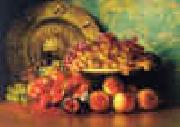 |
George Henry Hall -- Click Here
|
|
1825-1913
American painter. Brought up in Boston, he began his career as an artist at the age of 16. In 1849 he travelled with his friend Eastman Johnson to D?sseldorf. Hall studied at the K?nigliche Akademie for about a year, and after a further two years of study in Paris and Rome he returned in 1852 to New York where he settled. However, he remained an enthusiastic traveller and spent a total of more than 20 years abroad. |
|
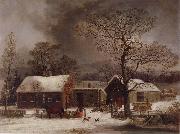 |
George Henry Durrie -- Click Here
|
|
American Painter, 1820-1863,American painter. Durrie and his older brother John (1818-98) studied sporadically from 1839 to 1841 with the portrait painter Nathaniel Jocelyn. From 1840 to 1842 he was an itinerant painter in Connecticut and New Jersey, finally settling permanently in New Haven. He produced c. 300 paintings, of which the earliest were portraits (e.g. Self-portrait, 1839; Shelburne, VT, Mus.); by the early 1850s he had begun to paint the rural genre scenes and winter landscapes of New England that are considered his finest achievement. His landscapes, for example A Christmas Party (1852; Tulsa, OK, Gilcrease Inst. Amer. Hist. & A.), are characterized by the use of pale though cheerful colours and by the repeated use of certain motifs: an isolated farmhouse, a road placed diagonally leading the eye into the composition, and a hill (usually the West or East Rocks, New Haven) in the distance. By the late 1850s Durrie's reputation had started to grow, and he was exhibiting at prestigious institutions, such as the National Academy of Design. In 1861 the firm of Currier & Ives helped popularize his work by publishing prints of two of his winter landscapes, |
|
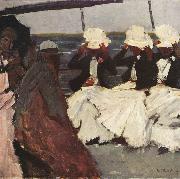 |
George Hendrik Breitner -- Click Here
|
|
Dutch Painter, 1857-1923
Dutch painter and photographer. He trained as a painter and draughtsman at the academy in The Hague. Although the Dutch painter Charles Rochussen taught the students history and landscape painting, Breitner's interests did not lie in this area. In 1880 he worked for a year in the studio of Willem Maris after his academy training. Maris belonged to the Hague school of painters, who worked in the plein-air tradition of the French Barbizon school. Breitner painted outdoor life with them, although it was not the picturesqueness of the landscape or the Dutch skies that appealed to him. With Van Gogh he roamed the working-class districts of The Hague and through the dockyards of Rotterdam. Both artists recorded the vitality of city life in their sketchbooks. Breitner consciously chose these themes and motifs: he wanted to paint people going about their daily lives |
|
|
|
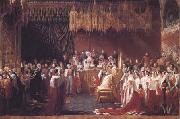 |
George Hayter -- Click Here
|
|
1792 - 1871
English painter and printmaker. He was the son of Charles Hayter (1761-1835), miniature painter, author of manuals for art instruction and Professor of Perspective and Drawing to Princess Charlotte. In 1808 George entered the Royal Academy Schools, and in 1815 was appointed Painter of Miniatures and Portraits by Princess Charlotte. Hayter was awarded the British Institution's premium for history painting for the Prophet Ezra (1815; Downton Castle, Heref. & Worcs), purchased by Richard Payne Knight. Encouraged by his patron, John Russell, 6th Duke of Bedford, he travelled to Italy to study in 1816, gaining election as an honorary member of the Accademia di S Luca in Florence. Returning to London in 1818, Hayter practised as a portrait painter in oils and history painter and occasionally acted as an art dealer. Dubbed 'The Phoenix' by William Beckford, Hayter showed a pomposity that irritated his fellow artists, but he mixed freely with many aristocratic families. |
|
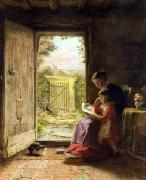 |
George Hardy -- Click Here
|
|
(1822-1909) was an English genre painter, a member of the Cranbrook Colony and eldest brother to Frederick Daniel Hardy.
Hardy was born in Brighton in Sussex the first son (of 8 children) of George Hardy (b. 1796 in London), a musician to George IV, Queen Adelaide, and Queen Victoria in the Royal household at Windsor. His mother was Sarah Lloyd (b. 1804).
Hardy became an oil painter of light-hearted genre subjects and moved to the artists' colony in Cranbrook in Kent. He married Ellen Hutton in May 1862 and the couple had 3 children.
Hardy died in Eastbourne in 1909.
|
|
|
|
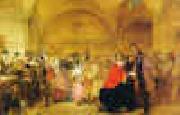 |
George Elgar Hicks -- Click Here
|
|
1824-1914
British
George Elgar Hicks Gallery
Born on March 13, 1824 in Lymington, Hampshire, George Elgar Hicks was the second son of a wealthy magistrate. His parents encouraged Hicks to become a doctor and so Hicks studied medicine at University College from 1840-42. However, after three years "ardous and disagreeable study" Hicks decided he wanted to be an artist. Due to this, Hicks began training as an artist considerably later in life than most artists of the time. In 1843, Hicks attended Sass's Academy and by 1844 had entered the Royal Academy Schools.
In 1847 Hicks married Maria Hariss and six of their eight children were born in the seven years following. He did not achieve much success as an artist during this period and later referred to his art at this time as "small and unimportant." He blamed this on the fact he had little time to study art or interact with other artists, due to his busy family life.
In 1859, Hicks painted his first large genre painting, Dividend Day. Bank of England (exhibited at the Royal Academy in 1859) following the success of Frith's paintings Ramsgate Sands and Derby Day at the Royal Academy. It was a typical genre painting, showing a scene from the Bank of England and featuring a broad range of social classes. Hicks painted several more large modern life paintings in the following years which were generally poorly reviewed by critics. These include The General Post Office. One minute to 6 (1860), Billingsgate Fish Market (1861) and Changing Homes (1862). Hicks paintings were often of subjects that no other artists attempted, such as the General Post Office and Billingsgate Fish Market. Hicks was one of the few artists that showed lasting interest in the emulation of Frith's style and is generally considered Frith's principal imitator.
By the late 1860s, the popularity of genre painting had waivered and Hicks began to focus on painting historical subjects, leading to society portraiture in the 1870s.
In 1884, Hicks remarried following the death of Maria in 1881. He retired in the 1890s and died a month before the declaration of World War I in 1914. |
|
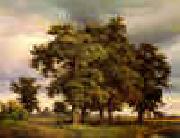 |
Georg-Heinrich Crola -- Click Here
|
|
1804-1879
German
Georg-Heinrich Crola Locations |
|
|
|
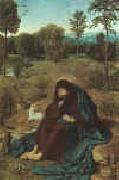 |
Geertgen Tot Sint Jans -- Click Here
|
|
Netherlandish Northern Renaissance Painter, ca.1460-1490
Geertgen tot Sint Jans is also known as Geertgen van Haarlem, Gerrit van Haarlem, or Gerrit Gerritsz.[citation needed] Alternative spellings of his first name are Gheertgen, Geerrit, and Gheerrit, where G(h)eertgen is the diminutive form of G(h)eerrit.
Presumably, he was born in Leiden, then in the Burgundian Netherlands in the Holy Roman Empire, around the year 1465. The assignment of Leiden as his birth place is traceable to a 17th century print by Jacob van Matham. There is no known archival evidence for this claim by Jacob van Matham. The modern acceptance of Leiden as Geertgen's birth place is roughly traceable to Johann Kessler's dissertation of 1930.
Probably, Geertgen was a pupil of Albert van Ouwater, who was one of the first oil painters in the northern Low Countries. Both painters lived in the city of Haarlem. Geertgen was attached to the monastery of the Knights of Saint John, for whom he painted an altarpiece. Although Geertgen was not a member of the Order of Saint John, his last name "tot Sint Jans" was derived from the order's name and means "unto Saint John".
Geertgen died in Haarlem, then the Habsburg Netherlands in the Holy Roman Empire, around the year 1495, when he was approximately 28 years old. He was buried in the monastery of the Knights of Saint John. Modern scholars have attempted to calculate the artist's death date with the information from The Painting-Book (Middle Dutch: Het Schilder-Boeck) by Karel van Mander, published in 1604. There are some archival traces that suggest he may in fact have lived into the 16th century. |
|
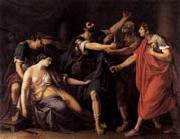 |
Gavin Hamilton -- Click Here
|
|
Scottish Neoclassical Painter, 1723-1798,Scottish painter, archaeologist and dealer, active in Italy. He was educated at Glasgow University and in 1748 arrived in Rome to study portrait painting under Agostino Masucci. He lodged with the architects James Stuart and Nicholas Revett; they probably encouraged him to visit Herculaneum and the recently discovered archaeological site of Pompeii, which had a profound effect on his subsequent career. Convinced that 'the ancients have surpassed the moderns, both in painting and sculpture', Hamilton undertook a systematic study of Classical antiquities during the 1750s and 1760s. In 1751 he was briefly in Scotland, where he painted a full-length portrait of Elizabeth Gunning, Duchess of Hamilton (Lennoxlove, Lothian), in a conventional style derived from van Dyck. He returned to Rome in 1752 and remained there, with the exception of short visits to England, for the rest of his life. In 1755 he was introduced by Anton Raphael Mengs to Johann Joachim Winckelmann, who was to become one of the leading theorists of Neo-classicism. In the same year Hamilton entertained Robert Adam, who studied in Rome from 1755 to 1757. He was to know and encourage almost all the British artists who worked in Rome during the second half of the 18th century. Henry Fuseli, who was not an uncritical admirer, wrote of Hamilton in 1805, |
|
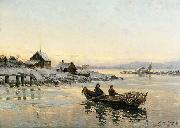 |
Frithjof Smith Hald -- Click Here
|
|
1846-1903, Norway
paint Til lands med fangsten in 1892 |
|
|
|
|
| | |
|
|
|
|